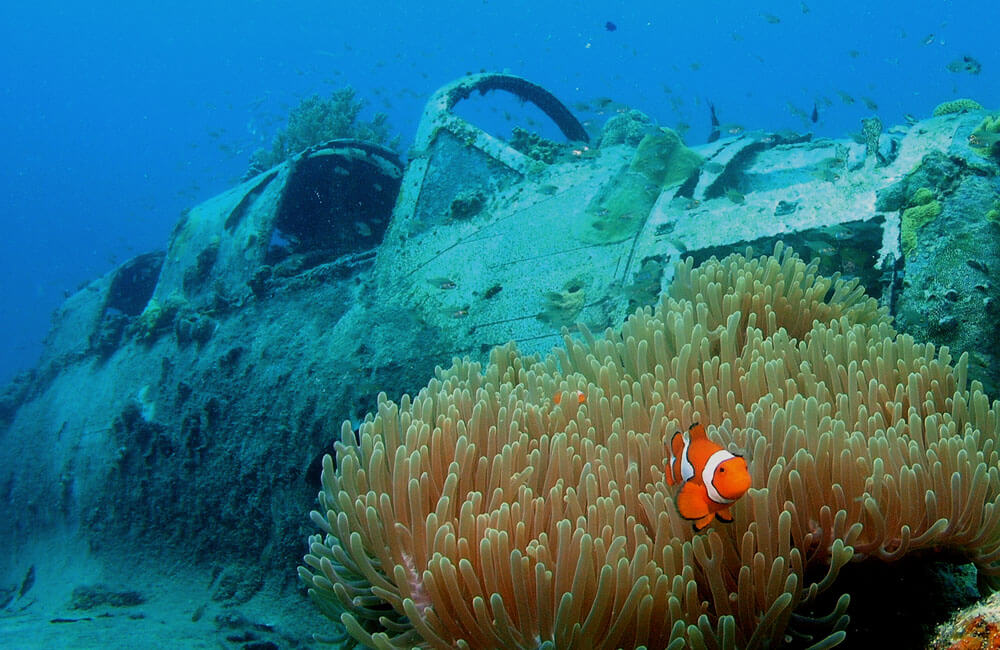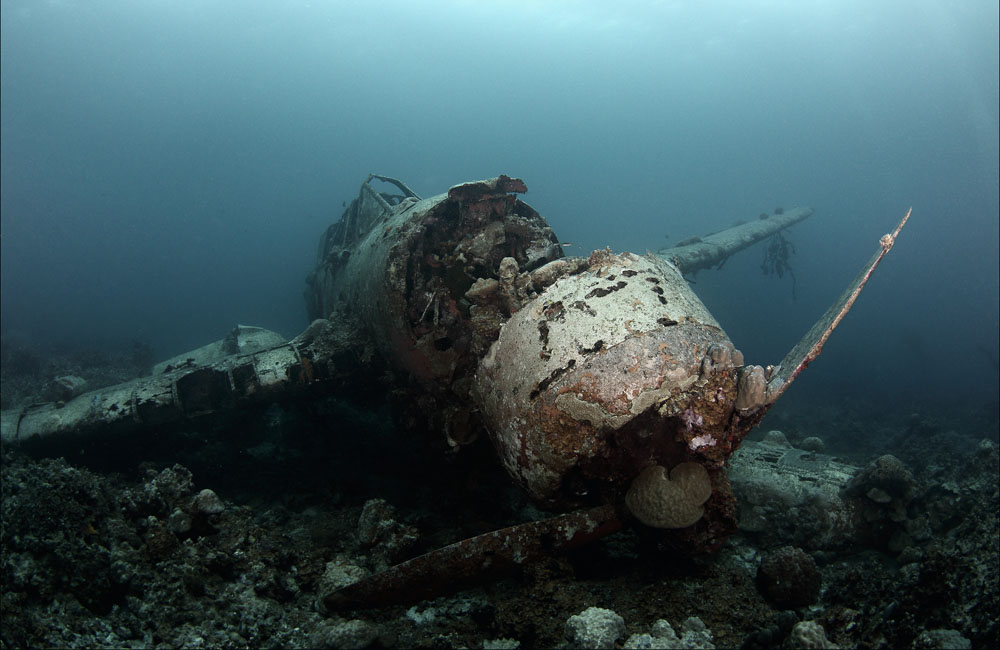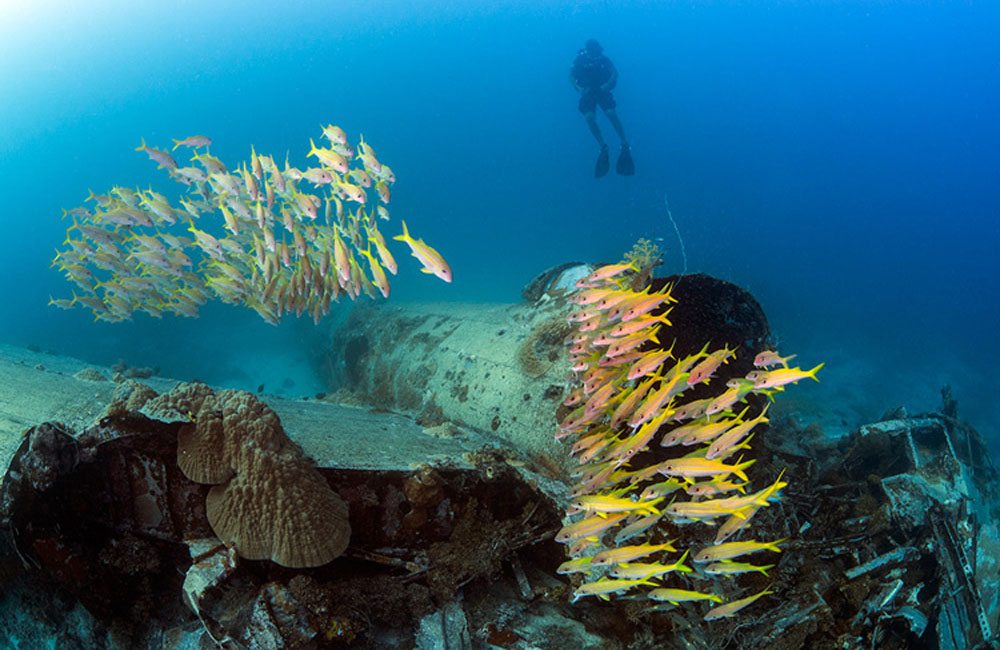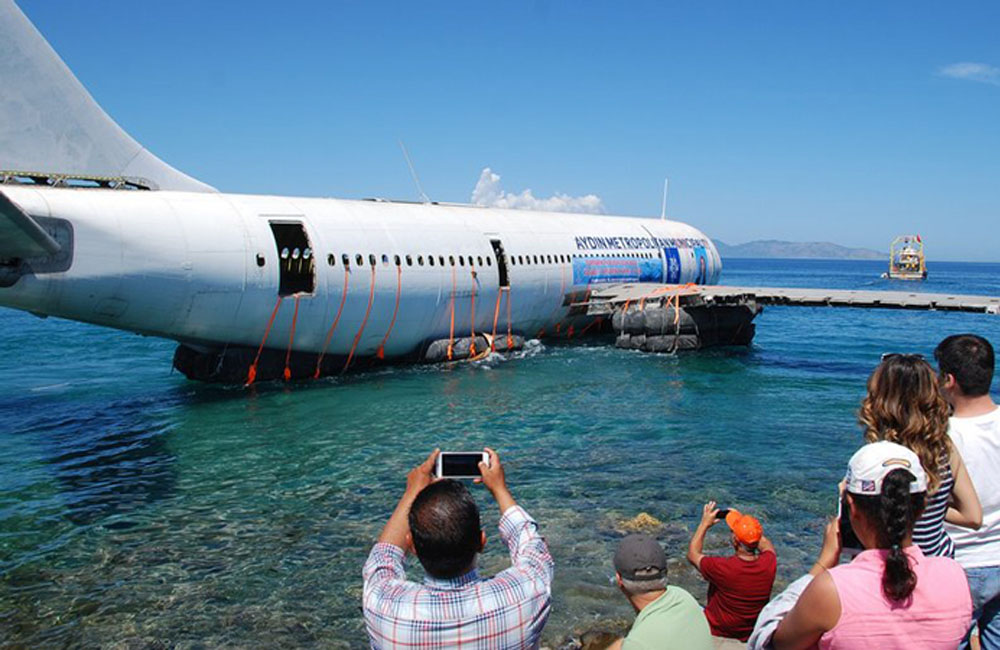
Wreck diving is one of the most popular activities for scuba divers around the world, both recreational and technical, and there’s little to compare with the sight of the often tragic majesty of a sunken vessel. Of all the vehicles lost at sea, however, aeroplanes that have come to a watery ending are especially eerie, as they were never supposed to be there in the first place. Here are some of the best aircraft wrecks around the world that scuba divers can enjoy
Bristol Blenheim Bomber, Malta

In December 1941, the Blenheim took off from its Maltese base only to be damaged during an attack shortly afterwards. Not wanting to risk damaging the airstrip should the aircraft crash-land, the pilots were ordered to bail out and ditch in the sea. The crew were rescued and the Blenheim came to rest around 800m east of Xrobb l-Ghagin along the Delimara coastline in Malta. At 42 metres, it’s a dive for the more experienced and although the aircraft has deteriorated over the years, it remains relatively intact, with the starboard engine’s propellers still affixed to the engine.
Bristol Beaufighter, Malta

Another popular wreck in Maltese water, the Bristol Beaufighter was forced to ditch on 17 March 1943 after suffering an engine failure, not far from Dragonara Point, Sliema. The crew survived and were rescued by Maltese Dgħajsas (water-taxis) before being transferred to a rescue launch. The twin-engined plane lies upside down in 40m of depth, with the 18m-wide wings, 13m-long fuselage and undercarriage visible.
Jake Seaplane, Palau

More than 60 Japanese ships were sunk around Palau during the Second World War, and in among the reefs is an Aichi E13A-1 Navy seaplane, codenamed the Jake by allied forces. Due to the relatively minor damage, especially to the straight blades of the propeller, it seems likely that the Jake sank while stationary, where it now rests upright among the coral in just 15m of water. Approximately 11m long and with a wingspan of 15m, the tail section has detached and lies a few metres away from the plane, and the whole craft has been overgrown with coral.
B-17 Black Jack, Papua New Guinea
Named the ‘Black Jack’ for the numbers 21 at the end of the plane’s serial number, the B17-F Bomber was returning to base on 11 July 1943 when engine failure while flying through a severe storm caused it to veer off-course and run out of fuel, where it ditched in the ocean not far from Boga Boga, Cape Vogel, on the northern coast of New Guinea. The crew survived and were rescued, but the Black Jack sank in 50m of water and – apart from damage to the nose from the impact – remains intact with most of its weaponry and equipment in place.
Emily flying boat, Truk Lagoon

Truk Lagoon is the site of the largest collection of Second World War wrecks following a highly successful surprise raid on the Japanese Naval base in February 1944. Among the many wrecks is a Kawnishi H8K1 Flying Boat – nicknamed ‘Emily’ by the Allied forces at the time – that was shot down during the raid, taking as many as five Allied fighters with her as she fell. Although the Mistubishi G4-M3 ‘Betty’ bomber located nearby is probably more famous, the 28m-long Emily flying boat – also known as ‘the flying porcupine’ for its many armaments – remains more intact as the aircraft managed to land before sinking upside-down in 15m of water.

Dakota DC3, Kas, Turkey

The Douglas DC3 – or C47 to use its military designation – was originally a transporter for a Turkish paratrooper regiment during the Second World War, deliberately sunk as a tourist attraction in 2009. The 20m-long aircraft sits upright and intact on the 26m deep sandy bottom with its undercarriage deployed, giving the impression that the Dakota is ready and waiting for take-off. The interior is open and experienced divers have the opportunity to penetrate the cockpit where the flight controls are still present.
Airbus A300, Kuşadasi, Turkey

Not content with sinking the Dakota, the Turkish government went bigger and, in 2016, sank a 54m long Airbus A300 near the resort of Kuşadasi, 50 miles south of Izmir. Thought to be the largest sunken aircraft in the world, Turkey hopes to promote the aircraft as an artificial reef, and a must-see for divers, to support the tourist industry in the region. And in 2019 they sunk another Airbus – an A330, just outside Ibrice Harbour.
Vought F4U Corsair, Oahu, Hawaii

In 1948, the pilot of the Corsair had just left Pearl Harbour when he noticed a problem with his fuel gauge, which rapidly progressed to engine failure and, unable to make it back to dry land, he executed what experts have described as the ‘perfect water landing’. Scrambling out of the cockpit, he watched his fighter sink into around 35m of seawater. The bent propellers indicate the Corsair sank nose-first but it otherwise remained undamaged. The starboard wing is buried in the sand, anchoring the plane against the strong current. Sharks, manta and other large pelagics are regularly spotted around the wreckage.
Renaissance planes, Aruba, Caribbean
The older of the two aircraft – which is either a Douglas DC3 or a Convair 240, and about which there is some discussion – was seized during a drug-smuggling operation in the late 80s and subsequently sunk in shallow water as an artificial reef. The aircraft was shifted into deeper water and broken up during a hurricane in 1999 but the fuselage remains mostly intact and is an easy penetration. The S-11 is a 40-seater formerly belonging to Air Aruba which was sunk in 2004 after reaching the end of its useable lifespan. Both planes are accessible in a single dive with the DC3 at around 25m and the S-11 in less than 15m.
Boeing 737-200, British Columbia, Canada
A former Air Canada airliner, the jet was acquired by Peter Luckham of the Artificial Reef Society of British Columbia, and was sunk in January 2006 near Chemainus to provide an artificial reef for marine life and to attract divers to the cold and often murky waters of the area. The aircraft was thoroughly sterilised before sinking, allowing for an easy penetration of the interior, free of seats and overhanging cables. The 30m long aircraft is 18m deep at its shallowest point and has attracted at least 117 different species since its sinking, according to a 2015 report.
C-130 Hercules, Aqaba, Jordan

The C-130 Hercules military transport aircraft was sunk in 2017 just off the coast of Aqaba, not far from the famous M-42 Duster ‘tank’, which can be visited in the same dive. With a maximum depth of only 18m in Aqaba’s clear and calm waters, the Hercules is an easy wreck for divers of all levels, and the cavernous interior has been opened making for an easy penetration. The huge tail section rises almost to the surface, and, situated close to shore, the Hercules can be enjoyed by divers and snorkellers alike.


